What Physical Characteristics Do Animals Living In A Desert Biome Have
What is the desert biome?
The desert biome is the characteristic community of animals and plants found in the world's deserts. Deserts are institute on every continent and brand upwards around 30 percentage of the globe'southward surface. The master characteristic of deserts is a shortage (or complete lack of) precipitation; some desert regions get for years on end without rain. Other characteristics of deserts include extremes of temperature and very piffling plant growth. The desert biome consists of species able to alive in these inhospitable conditions.
Since both plants and animals need water (and consist mostly of water), it seems logical that there would be picayune or no life in the world's nigh arid regions. Yet deserts support an array of organisms that, due to a variety of remarkable and ingenious adaptations, are able to survive in this unforgiving habitat.
On this page you'll observe facts on the desert biome, including: desert characteristics, the different types of desert, and the typical animal and constitute species found in deserts.
The Desert Biome Facts: Page Alphabetize
- Desert Characteristics
- Types Of Deserts And Their Locations
- Desert Organisms
- Desert Plants
- Desert Animals
- Is in that location life in Polar Deserts?
- Microbial Life in Desert Soils
- Threats to The Desert Biome
- Farther Reading & References
Other Desert Pages
- Desert Animals List with Pictures & Facts
- Desert Plants List with Pictures & Facts
Other Biome Pages on Active Wild
- The Marine Biome: Facts, Pictures, Ecosystems, Species & Threats
- Grasslands and the Grassland Biome: Facts, Pictures, Plants, Animals, Ecology & Threats
- The Tundra Biome Facts, Pictures & Information. Detect The World's Coldest, Harshest Biome
- What Is The Taiga Biome? Discover The Boreal Forests Of The Northern Hemisphere
Desert Characteristics
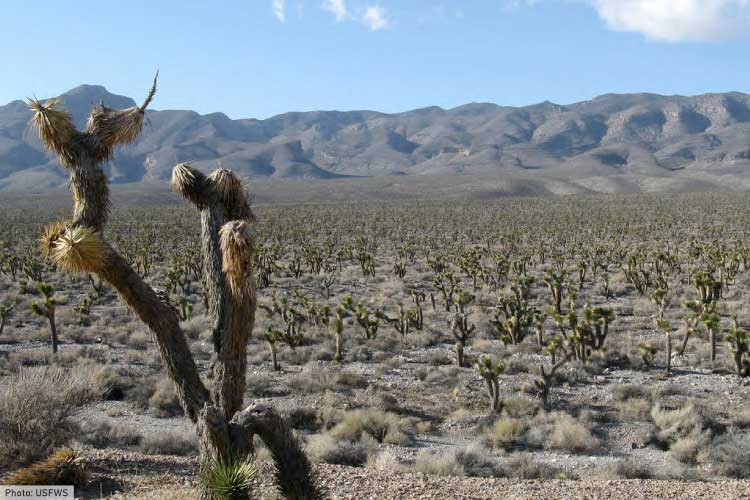
1. Low precipitation
Deserts experience extreme shortages of water due to lack of precipitation. The chief characteristic of deserts is that they are dry.
Deserts are commonly defined as areas that receive less than 10 in (250 mm) of rain annually. In that location are records of deserts going without pelting for hundreds of years, for example, the Atacama Desert in Chile. All the same, most deserts practice receive rain, even if only for a few days each year.
Desert rainfall is usually unpredictable. As a result desert animals and plants cannot rely on the presence of moisture for their growing or reproductive seasons – they must first wait for rain to arrive before completing their life cycles.
In addition, rainfall in deserts often comes in downpours. This causes flooding earlier the water is lost into the sandy soil.
2. Clear Skies / Extremes of temperature
The air is dry in deserts, and clouds do not course; therefore, clear skies are besides a characteristic of deserts.
The cloudless skies permit much of the sun'southward radiation to reach the footing, leading to very loftier daytime temperatures.
Similarly, once the sunday sets in a desert, the warmth is quickly radiated abroad into the atmosphere every bit there are no clouds to trap it. This causes very low temperatures at night.
Desert plants and animals must exist able to tolerate extremes of both heat and common cold.
3. Tiresome-growing Plants
Deserts are too characterized by having plants that grow very slowly. The process of photosynthesis (in which plants apply the sun's energy to make food for growth) requires water. Considering water is in short supply, plant production in deserts is the everyman of whatsoever biome on earth.
Types Of Deserts And Their Locations
Deserts have formed all over the world where moisture is scarce and unpredictable. The extent and crusade of the aridity varies, and this ways that no single definition fully describes the conditions in all deserts. Instead, ecologists recognise different major types of deserts:
1. Subtropical deserts
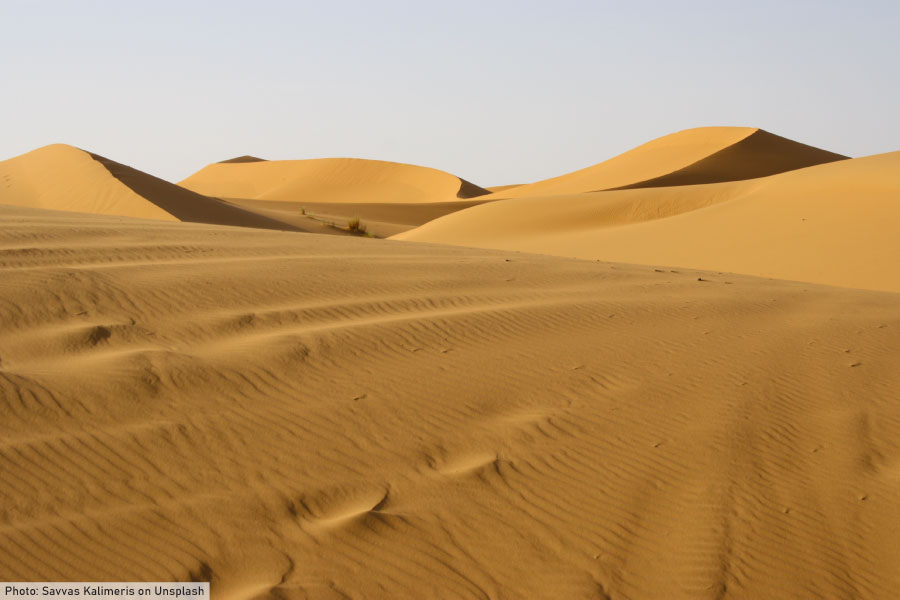
Subtropical deserts are very hot and dry. They occur at depression latitudes, to the south and north of the equator. The dry conditions are caused past patterns of atmospheric circulation that first over equatorial regions.
Africa's Sahara Desert is an example of a subtropical desert.
2. Temperate deserts / Cold Deserts
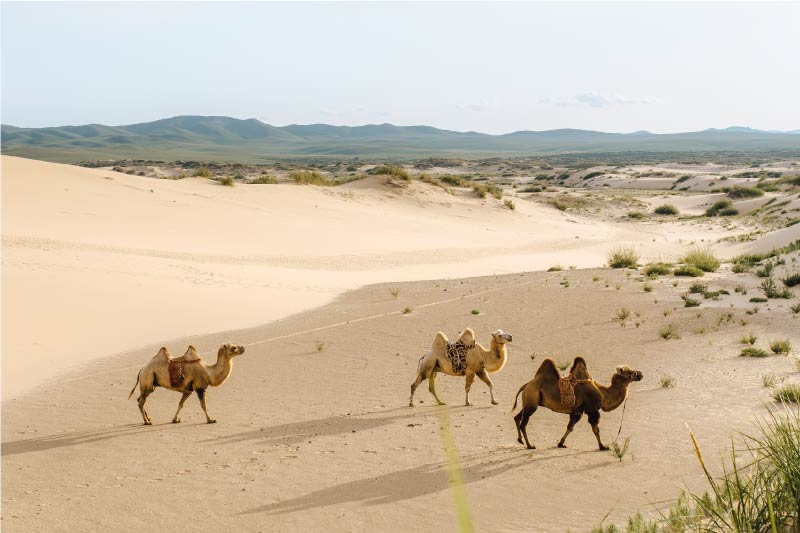
Temperate deserts, also known as cold deserts, occur at higher latitudes and therefore have libation temperatures. Their dehydration is caused by being far from the ocean or from existence close to loftier mountains that prevent moist air from reaching inland.
The largest temperate desert is the Gobi Desert of central Asia.
3. Coastal deserts
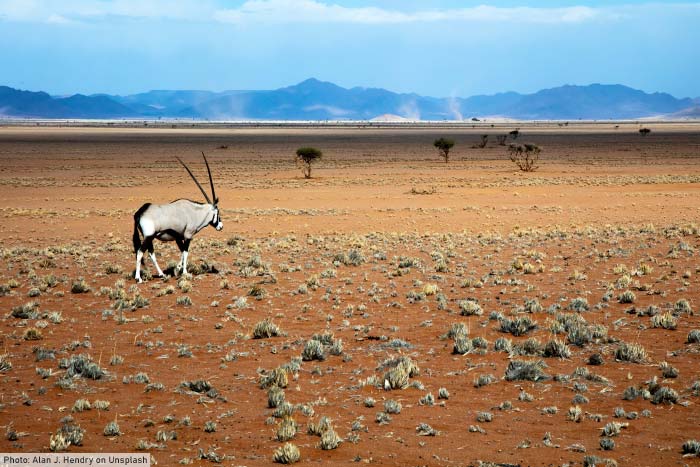
Littoral deserts occur close to the body of water. Although they receive little or no rainfall, fog brings wet inland, which provides a source of water for the deserts' inhabitants.
Examples of coastal deserts include the Namib of southern Africa and the Atacama Desert of Due south America.
4. Polar deserts
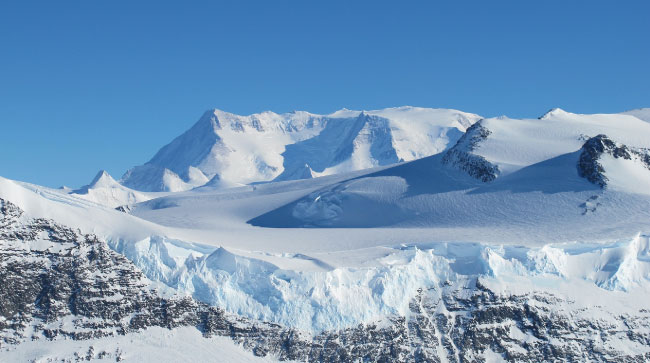
Polar deserts are regions that are permanently covered by water ice. Polar air is very dry out and produces fiddling or no rain. Globe's 2 largest deserts are polar deserts, one covering Antarctica; the other in the Arctic.
Desert Animals & Plants
The organisms living in deserts are mostly evolved from species that occurred in those regions long agone, when at that place was more h2o bachelor. This means that each desert has its own set of plants and animals.
However, all desert species–wherever they are found–must be able to survive with very niggling water, and besides to tolerate extreme temperatures.
Desert Biome Plants
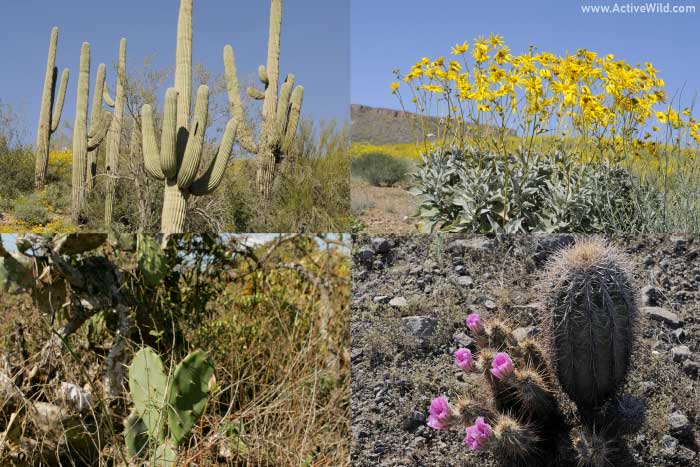
Desert plants must obtain moisture and shop it for times when no rain falls. Some accept a network of shallow roots that enables them to absorb moisture that falls onto the soil, including drops of dew or condensed fog. Others have deep tap roots that tin can accomplish water far beneath the surface.
Familiar desert plants include cacti, euphorbias and succulents, which all shop h2o and use it sparingly. They take a waxy cuticle on their leaves and stems and this helps prevent evaporation. They frequently accept spines that protect their leaves and stems from beingness eaten past herbivores looking for nutrient and moisture.
The almost diverse family of desert plants is the daisy family. These plants are therophytes, which means that they spend most of their lives equally seeds, just germinating when pelting has fallen. At such times, the desert sands go covered in colourful daisies, equally the plants race to produce flowers and form seeds before the moisture dries.
Other desert plants are geophytes that spend their lives as bulbs, hiding below the soil. They remain fallow and avoid the extreme temperatures until conditions are right for growth.
- You can discover out more virtually desert plants on this page: Desert Plants List with Pictures & Facts
Desert Biome Animals
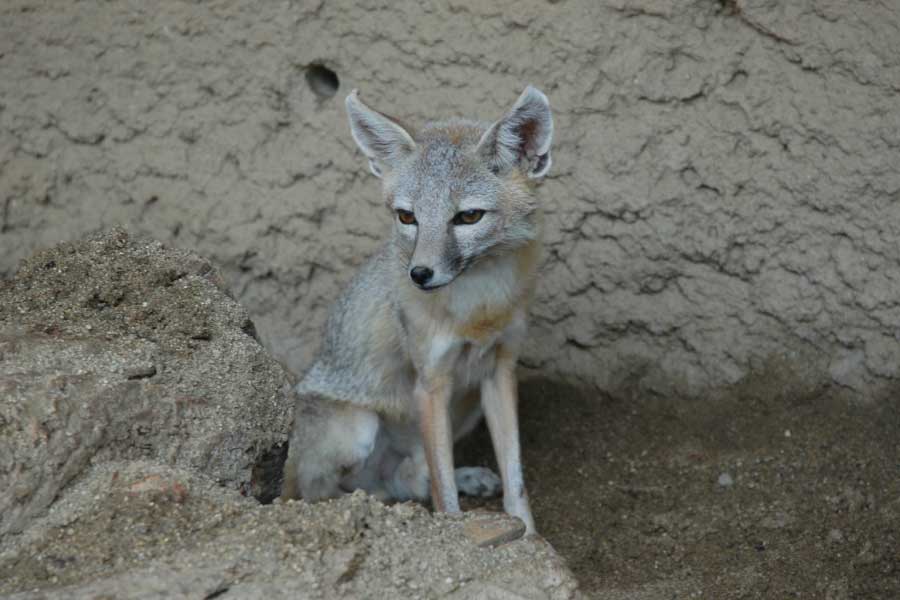
More than than half of desert animal species spend the majority of their time underground, either sleeping or hibernating. In this way, they escape the farthermost temperatures and tin can conserve water. This includes a variety of insects, arachnids, snakes, lizards and minor mammals.
In improver, many desert animals are nocturnal, searching for their food during the absurd desert nights.
Even a few species of amphibians, such every bit the desert rain frog of the Namib, can survive if they remain buried all twenty-four hour period. This species has no tadpole stage but develops from an egg straight into an developed – an adaptation to its arid environment.
The almost diverse group of desert mammals are rodents. They feed on seeds and accept the remarkable ability to survive without drinking. Instead, they use metabolic water, which is formed in their bodies equally a event of metabolizing food. Their kidneys can produce very full-bodied urine, which helps to remove torso waste without losing water.
Desert Kangaroo Rats in southwestern Northward America store seeds in their burrows; these seeds absorb water from the boiling air in the burrow, and act equally an additional source of wet.
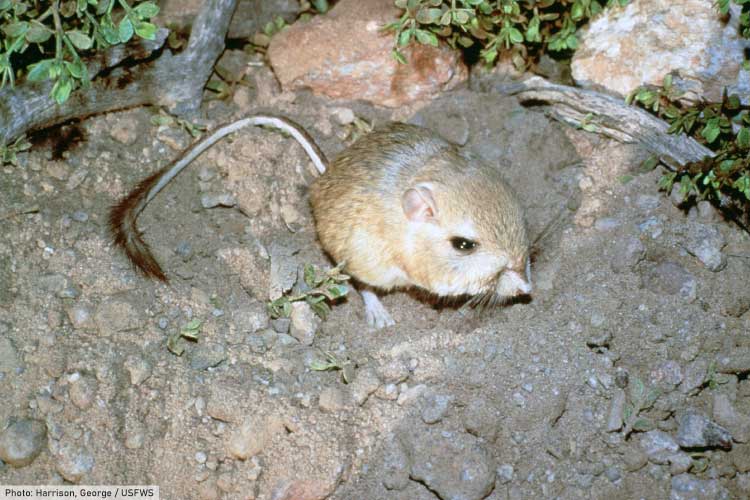
Rodents, in turn, are preyed upon by predators such every bit snakes, foxes, bobcats and owls that too live in deserts.
Big mammals are uncommon in deserts, although camels, gazelles, ibexes and oryxes occur in places, and are well adapted to the tough atmospheric condition.
Birds inhabit all deserts, fifty-fifty though they have higher trunk temperatures than mammals and cannot burrow. They lose heat through the sparse skin of their legs and will stand tall to expose their legs when hot.
Desert birds are often nomadic and tin move to places where pelting has recently fallen; they can also wing abroad when conditions become intolerable.
- Y'all can observe out more about desert animals on this page: Desert Animals List with Pictures & Facts
Is in that location life in Polar Deserts?
Polar deserts are covered in ice and practise non support any establish life. The temperatures are extremely low (less than 50oF/10oC in summer, and around -22oF/-30oC in winter) and rainfall is deficient (less than 1.five in/twoscore mm per year).
In addition, the polar regions spend a large part of the year in darkness. These conditions brand information technology impossible for plants to survive.
Until the 1970s information technology was idea that no life existed in polar deserts at all, simply it is now known that there are life forms known equally extremophiles that thrive in these inhospitable conditions.
Extremophiles are more often than not single-celled organisms such as leaner and archaea. They do not freeze, even at very low temperatures.
Microbial Life in Desert Soils
Although deserts are not comfy places for most living organisms, research has shown that, where soil is present, it supports a rich and diverse community of microbes, most of which are forms of bacteria.
These tiny organisms have critical roles in binding soil particles that may otherwise fly away in the wind. Many of the species survive by desiccating (simply not dying out completely) when no rain falls; others produce hardy spores that can remain dormant for years.
Even in the world's driest places, such as the Atacama Desert, life is thriving out of sight.
Threats to The Desert Biome
Changes in climate, brought about by global warming, will accept potentially devastating effects on those species that cling to being in the rigorous desert conditions.
In addition, human activeness brings changes to desert processes directly. Mining for minerals, oil and gas disturbs the sands and brings construction and vehicles to remote areas.
Grazing by domesticated animals, such as goats, disturbs the roots of plants and damages leaves which, due to slow growth rates, take a long time to replace. Trampling by herds, as well as off-road vehicle use, compacts the soil and destroys the microbes that bind the grains. This leads to erosion and desertification which results in desert areas condign fifty-fifty more arid and inhospitable.
Many specialist desert organisms have become threatened or extinct in recent years every bit a consequence of devil-may-care human utilize of these fragile and magical ecosystems.
Further Reading & References
You can find out more virtually the desert biome and life in deserts on the following pages:
- Desert Animals List with Pictures & Facts
- Desert Plants Listing with Pictures & Facts
- Sahara Desert Facts For Kids & Students With Pictures, Data & Video
- Is Antarctica A Desert?
Article References
- Lovegrove, B. G. 1993. The Living Deserts of Southern Africa. Fernwood Printing, Greatcoat Town, South Africa. ISBN 0-958315 -7-vii.
- Pennisi, E. 2018. Microbes establish in one of Globe's most hostile places, giving hope for life on Mars. American Association for the Advocacy of Science: Science Mag. Accessed 16 Baronial 2020 from source
- Smith, J.Grand.B. 2020. Desert. Encyclopaedia Britannica. Accessed on fourteen August 2020, from source
- Traynor, K. 2010. Sonoran CIS. Arizona Land University School of Life Sciences. Accessed on sixteen August 2020 from source
- UNLV. Deserts: definitions and characteristics. Academy of Nevada, Las Vegas, Kinesthesia Sites. Accessed on 14 August 2020, from source
- Wikipedia. Desert. Accessed on xi Baronial 2020, from source
Source: https://www.activewild.com/desert-biome/
Posted by: mcnamaragulay1979.blogspot.com

0 Response to "What Physical Characteristics Do Animals Living In A Desert Biome Have"
Post a Comment